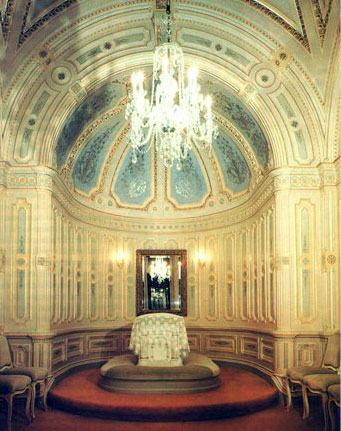Difference between revisions of "Mormon Temple Ritual"
Elya Ghent (talk | contribs) |
|||
| Line 1: | Line 1: | ||
| − | [[Image:Mormon_Temple_Ritual.jpg|300px|thumb|left|alt=Mormon Temple Ritual|The sealing room of the Manti Utah | + | [[Image:Mormon_Temple_Ritual.jpg|300px|thumb|left|alt=Mormon Temple Ritual|The sealing room of the Manti Utah Temple]] |
The word ''ritual'' is defined as follows: : | The word ''ritual'' is defined as follows: : | ||
Revision as of 16:50, 31 July 2020
The word ritual is defined as follows: :
- Of or relating to rites or a ritual: ceremonial, such as a ritual dance.
- According to religious law, as in ritual purity.
- done in accordance with social custom or normal protocol, as in ritual patterns of movement.
The word ritual derives from the word rite. A rite is defined as follows:
- A prescribed form or manner governing the words or actions for a ceremony.
- The ceremonial practices of a church or group of churches.
Mormon Temple Ritual
Using the above definitions, the temples of The Church of Jesus Christ of Latter-day Saints include the performance of rituals in the following ways:
1. Ceremonies are performed in Mormon temples. The most ceremonial event enacted in Mormon temple ritual is the marriage ceremony, in which a man and woman are united in an eternally-binding covenant, depending on their continued worthiness (purity). This ceremony is not unlike the pattern of a Protestant wedding ceremony, except that the vows refer to an eternity together and pronounce eternal blessings upon the marriage. The other difference is that the couple must qualify in righteousness to enter the temple.
2. Mormon temple ritual follows religious law, and purity is a prerequisite for entering the temple. Most temple rites (see Baptism for the Dead, Mormon Endowment, Celestial marriage) are repeated verbatim every time. In fact, the pattern of words is very important, because of the meaning they convey, which must be clear and repetitive. The Holy Ghost, through personal revelation to the person attending, delivers new insights when a person attends prayerfully. Thus, each time a Mormon participates in Mormon temple ritual, he or she goes away more enlightened.
3. The protocol used in Mormon temple ritual has been received by revelation line upon line and precept upon precept. Most of the protocol was revealed by God to Joseph Smith, the first prophet of the Last Days, and founder of the LDS Church. However, the protocol was received gradually. Baptism for the Dead, for instance, was not practiced until the Latter-day Saints were established in Nauvoo, Illinois. Other small changes have been made more recently, according to received revelation. A few changes have come because of technological improvements. For instance, parts of the instruction on the creation and Plan of Salvation used to be presented live, but now are presented in a film. This has enabled easier translation into foreign languages as temples are built all over the world.
4. Ritual pertains to a prescribed religious ceremony, and therefore, all churches incorporate some sort of ritual into their religious practice. Much of ritual is symbolic, and other aspects imbue the ceremony with importance and encourage reverence. The first time members engage in Mormon temple ritual, they do so for themselves. After that, they do so for the dead who have not received the saving ordinances of the temple. The dead have free agency and are able to choose for themselves whether or not to accept the ordinances performed for them. This work blesses the living, who are able to review the Mormon temple ritual again and again, receiving more enlightenment each time.
There is nothing secretive or bizarre about Mormon temple ritual, and all that is done in the temple is pure, innocent and light. However, Mormon temple ritual does hearken back to ancient times and is highly symbolic. Therefore, it is different in style than a Mormon Sunday meeting in a Mormon meetinghouse.
